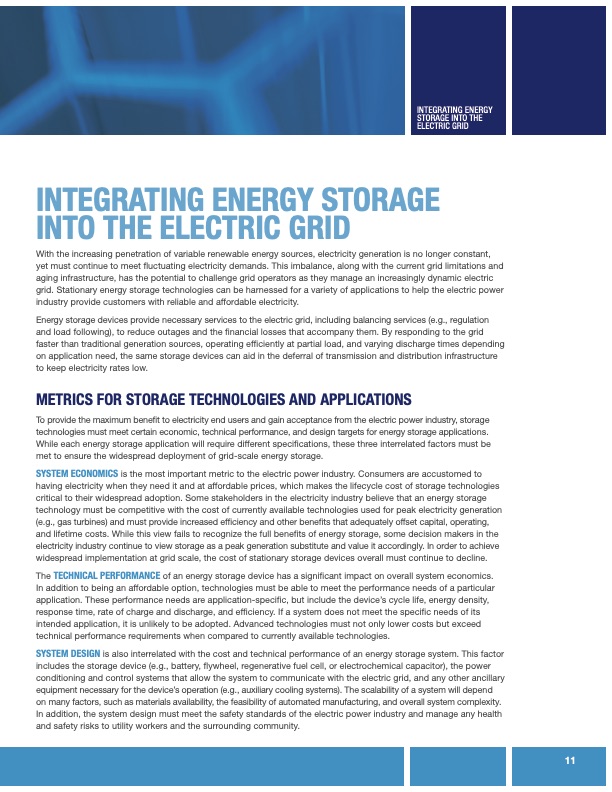
PDF Publication Title:
Text from PDF Page: 015
INTEGRATING ENERGY STORAGE INTO THE ELECTRIC GRID With the increasing penetration of variable renewable energy sources, electricity generation is no longer constant, yet must continue to meet fluctuating electricity demands. This imbalance, along with the current grid limitations and aging infrastructure, has the potential to challenge grid operators as they manage an increasingly dynamic electric grid. Stationary energy storage technologies can be harnessed for a variety of applications to help the electric power industry provide customers with reliable and affordable electricity. Energy storage devices provide necessary services to the electric grid, including balancing services (e.g., regulation and load following), to reduce outages and the financial losses that accompany them. By responding to the grid faster than traditional generation sources, operating efficiently at partial load, and varying discharge times depending on application need, the same storage devices can aid in the deferral of transmission and distribution infrastructure to keep electricity rates low. METRICS FOR STORAGE TECHNOLOGIES AND APPLICATIONS To provide the maximum benefit to electricity end users and gain acceptance from the electric power industry, storage technologies must meet certain economic, technical performance, and design targets for energy storage applications. While each energy storage application will require different specifications, these three interrelated factors must be met to ensure the widespread deployment of grid-scale energy storage. SYSTEM ECONOMICS is the most important metric to the electric power industry. Consumers are accustomed to having electricity when they need it and at affordable prices, which makes the lifecycle cost of storage technologies critical to their widespread adoption. Some stakeholders in the electricity industry believe that an energy storage technology must be competitive with the cost of currently available technologies used for peak electricity generation (e.g., gas turbines) and must provide increased efficiency and other benefits that adequately offset capital, operating, and lifetime costs. While this view fails to recognize the full benefits of energy storage, some decision makers in the electricity industry continue to view storage as a peak generation substitute and value it accordingly. In order to achieve widespread implementation at grid scale, the cost of stationary storage devices overall must continue to decline. The TECHNICAL PERFORMANCE of an energy storage device has a significant impact on overall system economics. In addition to being an affordable option, technologies must be able to meet the performance needs of a particular application. These performance needs are application-specific, but include the device’s cycle life, energy density, response time, rate of charge and discharge, and efficiency. If a system does not meet the specific needs of its intended application, it is unlikely to be adopted. Advanced technologies must not only lower costs but exceed technical performance requirements when compared to currently available technologies. SYSTEM DESIGN is also interrelated with the cost and technical performance of an energy storage system. This factor includes the storage device (e.g., battery, flywheel, regenerative fuel cell, or electrochemical capacitor), the power conditioning and control systems that allow the system to communicate with the electric grid, and any other ancillary equipment necessary for the device’s operation (e.g., auxiliary cooling systems). The scalability of a system will depend on many factors, such as materials availability, the feasibility of automated manufacturing, and overall system complexity. In addition, the system design must meet the safety standards of the electric power industry and manage any health and safety risks to utility workers and the surrounding community. INTEGRATING ENERGY STORAGE INTO THE ELECTRIC GRID 11PDF Image | Devices for Stationary Electrical Energy Storage Applications

PDF Search Title:
Devices for Stationary Electrical Energy Storage ApplicationsOriginal File Name Searched:
AdvancedMaterials_12-30-10_FINAL_lowres.pdfDIY PDF Search: Google It | Yahoo | Bing
Turbine and System Plans CAD CAM: Special for this month, any plans are $10,000 for complete Cad/Cam blueprints. License is for one build. Try before you buy a production license. More Info
Waste Heat Power Technology: Organic Rankine Cycle uses waste heat to make electricity, shaft horsepower and cooling. More Info
All Turbine and System Products: Infinity Turbine ORD systems, turbine generator sets, build plans and more to use your waste heat from 30C to 100C. More Info
CO2 Phase Change Demonstrator: CO2 goes supercritical at 30 C. This is a experimental platform which you can use to demonstrate phase change with low heat. Includes integration area for small CO2 turbine, static generator, and more. This can also be used for a GTL Gas to Liquids experimental platform. More Info
Introducing the Infinity Turbine Products Infinity Turbine develops and builds systems for making power from waste heat. It also is working on innovative strategies for storing, making, and deploying energy. More Info
Need Strategy? Use our Consulting and analyst services Infinity Turbine LLC is pleased to announce its consulting and analyst services. We have worked in the renewable energy industry as a researcher, developing sales and markets, along with may inventions and innovations. More Info
Made in USA with Global Energy Millennial Web Engine These pages were made with the Global Energy Web PDF Engine using Filemaker (Claris) software.
Sand Battery Sand and Paraffin for TES Thermo Energy Storage More Info
| CONTACT TEL: 608-238-6001 Email: greg@infinityturbine.com | RSS | AMP |